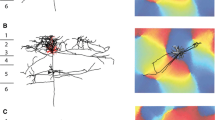Summary
Pyramidal tract neurons of cats under chloralose anesthesia have been classified with respect ot their axonal conduction velocity in two groups of fast and slow conducting neurons. Afferent connections of both groups have been analyzed. A significantly higher response rate of fast PT units has been established after electric stimulation of cutaneous nerves of both forepaws, stimulation of the thalamic ventrolateral nucleus as well as after photic stimulation of the contralateral eye. Depending on the site of stimulation, 74–93% of the fast PT units could be excited, but under the same conditions only 28–53% of the slow PT units showed spike responses. The latencies of the responses were equal for both cell types with stimulation of ipsilateral forepaw or the eye. However when a stimulus was applied at the ventrolateral nucleus, fast PT units only showed a response after a latency of less than 5 msec. When the contralateral forepaw was stimulated, 60% of the fast PT units, but none of the slow ones responded within the first 22 msec after stimulation. The conclusion has been made that crossed oligosynaptic connections from cutaneous afferents may project exclusively to the fast PT units.
Zusammenfassung
Pyramidenbahnneurone chloralosenarkotisierter Katzen wurden nach der Leitungsgeschwindigkeit ihrer Axone in schnelleitende (sPTN) und langsamleitende (IPTN) eingeteilt und afferente Verbindungen beider Zellpopulationen untersucht. Bei elektrischer Reizung der Hautnerven beider Vorderpfoten, sowie im Nucleus ventrolateralis des Thalamus und auch bei photischer Reizung des kontralateralen Auges fand sich eine signifikant größere Ansprechbarkeit der sPTN. Je nach Reizstelle reagierten 74–93% der sPTN, aber nur 28–53% der IPTN mit Spikeentladungen. Die Latenzzeiten dieser Entladungen waren nach Reizung der ipsilateralen Vorderpfote und nach photischen Reizen bei beiden Zellpopulationen etwa gleich. Hingegen reagierten bei Reizung des Nucleus ventrolateralis nur die sPTN innerhalb der ersten 5 msec. Bei Reizung des Hautnerven der kontralateralen Vorderpfote zeigten 60% der sPTN, aber keine IPTN eine Entladung innerhalb der ersten 22 msec nach dem Reiz. Die Resultate legen die Annahme einer gekreuzten oligosynaptischen Verbindung von Hautafferenzen zu den sPTN nahe.
Similar content being viewed by others
Literatur
Adrian, E. D., Moruzzi, G.: Impulses in the pyramidal tract. J. Physiol. (Lond.)97, 153–199 (1939).
Amassian, V. E., Weiner, H.: Monosynaptic and polysynaptic activation of pyramidal tract neurons by thalamic stimulation. In: D. P. Purpura and M. D. Yahr (Eds.). The Thalamus, p. 225. New York-London: Columbia University Press 1966.
Ascher, P., Buser, P.: Modalités de mise en jeu de la voie pyramidale chez le chat anesthésie au chloralose. J. Physiol. (Paris)50, 129–132 (1958).
Brooks, V. B., Rudomin, P., Slayman, C. L.: Peripheral receptive fields of neurons in the cat's cerebral cortex. J. Neurophysiol.21, 302–325 (1961).
Buser, P.: Subcortical control of pyramidal activity. In: D. P. Purpura, and M. D. Yahr (Eds.): The Thalamus, p. 323. New York-London: Columbia University Press 1966.
—, Ascher, P.: Mise en jeu réflexe du système pyramidal chez le chat. Arch. ital. Biol.98, 123–163 (1960).
—, Imbert, M.: Sensory projections to the motor cortex in cats: a microelectrode study. In: W. A. Rosenblith (Ed.): Sensory communication, p. 607. New York: Wiley 1961.
—, Kitsikis, A., Wiesendanger, M.: Modulation of visual input to single neurons of the motor cortex by the primary visual area in the cat. Brain Res.10, 262–265 (1968).
Evarts, E. V.: Relation of discharge frequency to conduction velocity in pyramidal tract neurons. J. Neurophysiol.28, 216–228 (1965).
—: Pyramidal tract activity associated with a conditioned hand movement in the monkey. J. Neurophysiol.29, 1011–1027 (1966).
Hassler, R., Muhs-Clement, K.: Architektonischer Aufbau des sensomotorischen und parietalen Cortex der Katze. J. Hirnforsch.6, 377–420 (1964).
Jasper, H. H., Ajmone-Marsan, C.: Stereotaxic atlas of the diencephalon of the cat. Ottawa: The National Research Council of Canada 1954.
Koike, H., Okada, Y., Oshima, T.: Accommodative properties of fast and slow pyramidal tract cells and their modification by different levels of their membrane potential. Exp. Brain Res.5, 189–201 (1968).
Kornhuber, H. H., Aschoff, J. C.: Somatisch-vestibuläre Integration an Neuronen des motorischen Cortex. Naturwissenschaften51, 62–63 (1964).
Megirian, D., Troth, R.: Vestibular and muscle nerve connections of pyramidal tract neurons of cat. J. Neurophysiol.27, 481–492 (1964).
Naito, H., Nakamura, K., Kurosaki, T., Tamura, Y.: Precise location of fast and slow pyramidal tract cells in cat sensorimotor cortex. Brain Res.14, 237–239 (1969).
Patton, H. D., Towe, A. L., Kennedy, T. T.: Activation of pyramidal tract neurons by ipsilateral cutaneous stimuli. J. Neurophysiol.25, 501–514 (1962).
Takahashi, K.: Slow and fast groups of pyramidal tract cells and their respective membrane properties. J. Neurophysiol.28, 908–924 (1965).
—, Kubota, K., Uno, M.: Recurrent facilitation in cat pyramidal tract cells. J. Neurophysiol.30, 22–34 (1967).
Towe, A. L., Patton, H. D., Kennedy, T. T.: Properties of the pyramidal system in cat. Exp. Neurol.8, 220–238 (1963).
—, Whitehorn, D., Nyquist, I. K.: Differential activity among wide-field neurons of the cat postcruciate cerebral cortex. Exp. Neurol.20, 497–521 (1968).
Tsukahara, N., Fuller, D. R. G., Brooks, V. B.: Collateral pyramidal influences on the corticorubrospinal system. J. Neurophysiol.31, 467–484 (1968).
Yoshida, M., Yajima, K., Uno, M.: Different activation of the two types of the pyramidal tract neurones through the cerebellothalamocortical pathway. Experientia (Basel)22, 331 (1966).
Author information
Authors and Affiliations
Additional information
Mit Unterstützung der Kredite 4447 und 4356 des Schweizerischen Nationalfonds für die wissenschaftliche Forschung.
Für bereitwillige Mitarbeit danken wir herzlich: Elektronik: P. Stoller; Operation: A. Fäh; Foto: L. Decoppet; Histologie: I. Gyarmati; Elektroden und Grafiken: S. Bollinger. Herrn Prof. Dr. K. Akert, Herrn Prof. Dr. G. Baumgartner und Herrn PD Dr. M. Wiesendanger danken wir für wohlwollende Beratung und Kritik.
Rights and permissions
About this article
Cite this article
Wettstein, A., Handwerker, H.O. Afferente Verbindungen zu schnell- und langsamleitenden Pyramidenbahnneuronen der Katze. Pflugers Arch. 320, 247–260 (1970). https://doi.org/10.1007/BF00587456
Received:
Issue Date:
DOI: https://doi.org/10.1007/BF00587456



